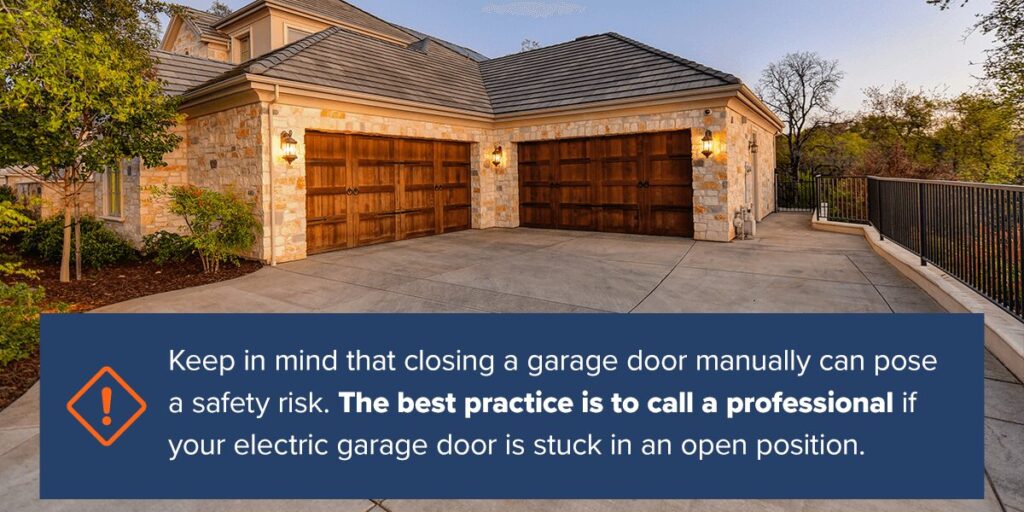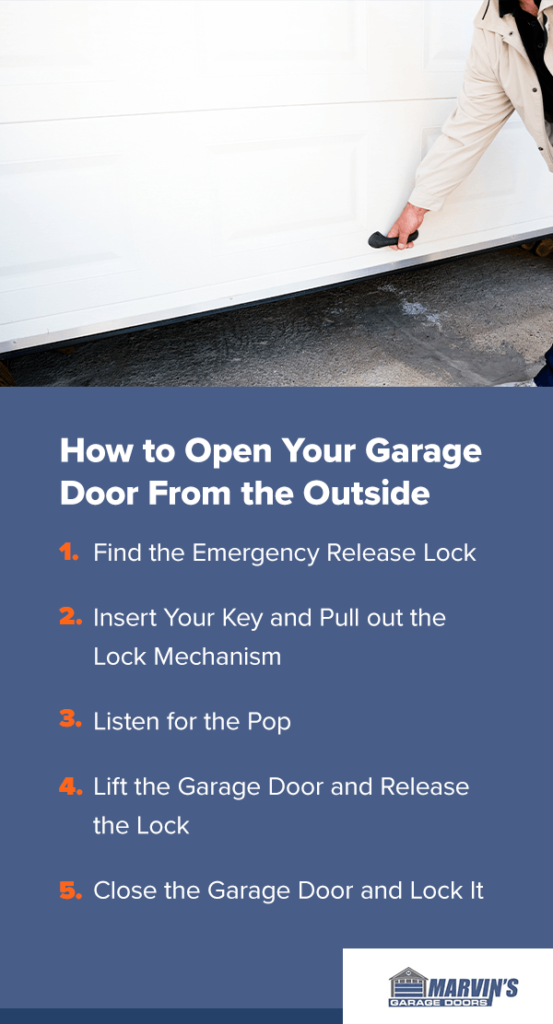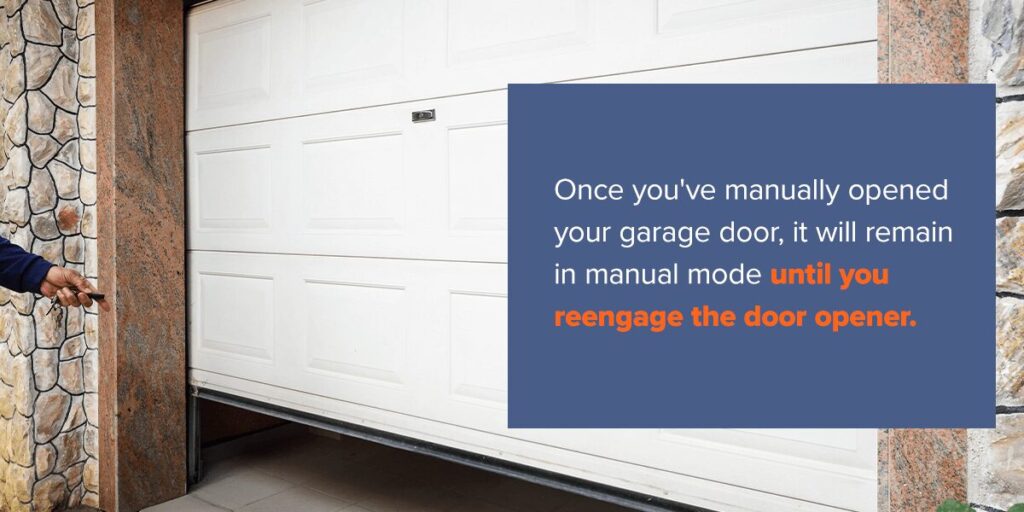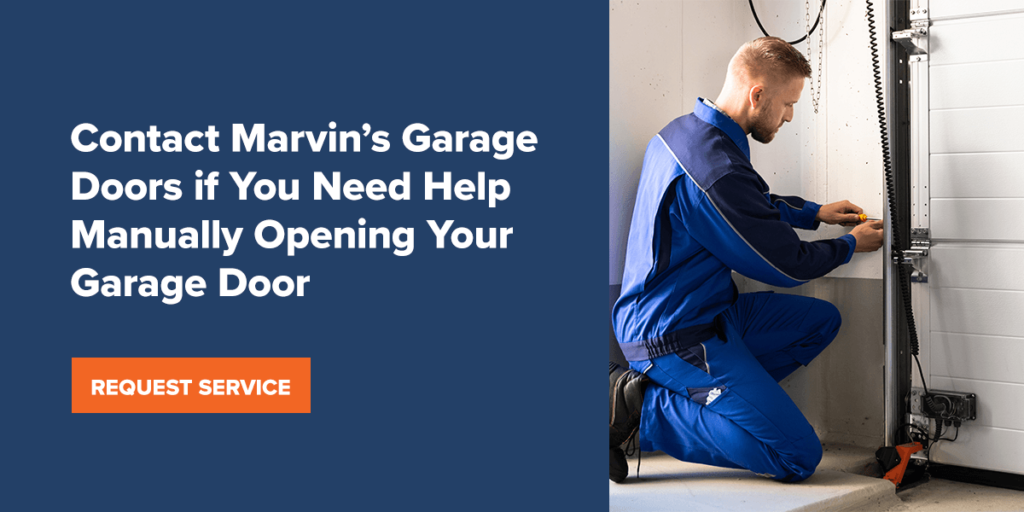
When your electric garage door becomes stuck in a closed or open position due to a power outage, a lost remote or spring damage, you want to find a fix quickly.
At Marvin’s Garage Doors, we understand that you need swift, easy solutions to get that garage door working again. We’ve created this guide to give you practical ways to get in and out of a stuck garage, so the next time you’re dealing with an unmoving door, you’ll know just how to fix it and who to contact if the issue is one for the professionals.
Jump to Section:
- How to Open Your Garage Door From the Inside
- What to Do if Your Garage’s Emergency Release Cord Breaks
- How to Open Your Garage Door From the Outside
- Safety Precautions for Manually Opening Your Garage Door
- How to Return the Garage Door to Automatic Mode
How to Open Your Garage Door From the Inside
If your garage connects to your home through an interior door, you’re in luck — opening your garage door manually from the inside is somewhat easier than getting it open from the outside.
How does manual release for a garage door work? You can get the door open manually by following these steps:
1. Check the Torsion Springs
Look at the tightly coiled metal springs directly above your garage door to see if they’re broken. These are called torsion springs, and if they’re damaged, they can’t provide the power needed to lift the door. In that case, call a professional to look at the springs before attempting to manually open the door — broken torsion springs can be highly dangerous.
2. Locate the Bypass Switch
If your torsion springs are intact, you can start the manual opening process by finding the bypass switch. The bypass switch allows you to override the system and manually lift the door open when needed. Look for a red rope with a T-shaped handle dangling from the garage door’s trolley.
3. Ensure the Garage Door Is Closed
Ensure the garage door is properly closed before you take any action. If your garage door is stuck halfway open, and the spring inside the door is broken, the garage door will be let loose and could fall when manual mode is engaged. Unexpected movement could damage the garage door and anything beneath it. If your garage door is stuck open, contact a repair service to fix it safely.
4. Pull the Release Cord
Pull the red rope down by the handle toward the door. This disengages a pin that connects the trolley to the automated opener. Depending on the cord’s length and your garage’s height, you may need a ladder to safely reach the rope.
5. Listen for the “Pop”
Once the electric mechanism successfully disengages, you should be able to hear a “pop” sound. This means the door has been disconnected from the motor.
6. Lift the Garage Door by Hand
Once you’ve heard the pop, you should be able to lift the garage door easily. Grip the bottom of the door with both hands, your back straight and legs bent, and slowly lift the garage door until it’s at its highest possible point. Make sure it’s open entirely to avoid having it slide back down.
7. Feel for Resistance
Your garage door should open smoothly after you’ve pulled the release cord and heard it disengage the electric opener. If it doesn’t, there could be a problem with the torsion springs, or the door could have come off its track. In either case, trying to force the door open will only cause more damage. Close the garage door and contact a professional.

8. Close the Garage Door
When closing the garage door, lower it slowly by pulling it down and bend your knees when the bottom of the door reaches waist height. Let it gently touch the floor, then lock it by moving the lock bar to the side, ensuring it goes through the track.
Keep in mind that closing a garage door manually can pose a safety risk. The best practice is to call a professional if your electric garage door is stuck in an open position. Even if your torsion springs look fine, they may still be compromised with damage only noticeable by a trained eye. If the springs cannot hold the door’s weight, pulling the release chord could lead to the door falling fast and hard, endangering the welfare of people, pets, vehicles and the garage door itself.
What to Do if Your Garage’s Emergency Release Cord Breaks
You can only operate your garage door manually if the emergency release cord is functional. Be sure to maintain it and check for damage, which might include:
- A cracked handle.
- Rust or corrosion.
- Fraying on the cord.
If the emergency release cord is not usable, you’ll have to replace it. You can call in a professional to perform the replacement, or you can do it yourself by following these steps:
- Cut off or untie the broken cord to detach it from the lever.
- Thread the new cord through the handle.
- Tie the cord in a knot to secure it.
- Thread the other end through the mechanism.
- Trim any excess cord.
- Prevent fraying by heating the end of the cord with a lighter.
How to Open Your Garage Door From the Outside

How you manually open a garage door from the outside depends on your garage’s setup. Some garages have no other access point than the garage door itself. In this situation, you can’t access the inside of the garage to pull on the release rope.
However, some garage doors have an emergency release lock and key. If your door has this feature, you will be able to access your garage from the outside, even when the door isn’t working electronically. Opening your garage door without electricity can be done in a few quick steps:
1. Find the Emergency Release Lock
The emergency release lock, also known as the vault lock or quick release lock, is usually positioned in the center of the garage door, near the top or at eye level. This lock is connected to the carriage via a cable and performs the same job as the release cord inside the garage.
2. Insert Your Key and Pull out the Lock Mechanism
Insert the key and turn it counterclockwise. Pull the entire mechanism out of the door. You’ll see a cable attached to it that runs through the small hole in your garage door. Pull the mechanism out so the cable moves toward you through the hole and releases the pin inside the garage.
3. Listen for the Pop
Like the release cord method inside the garage, there will be a “pop” once the electric opener has been disengaged. Because you’re outside, you may be unable to hear it. If you’ve pulled out the cable all the way, though, you’ll likely have switched to manual opening.
4. Lift the Garage Door and Release the Lock
Now, you can bend down with a straight back and bent knees and slowly lift the garage door. You can let go of the release lock and cable, as they will move out of reach as the door opens.
5. Close the Garage Door and Lock It
When you’re done in the garage, grab the handle or base of the garage door and gently lower it back to the ground. As the garage door descends, the exposed cable attached to the lock mechanism will shorten and pull it back into the hole. Once the door is completely closed and the mechanism is snugly in place, you can lock the mechanism back in place by turning the key clockwise.
If you have no way to access your garage besides the closed garage door and no emergency release lock and key, you’ll need to get in touch with a professional garage door technician. A garage door repair service will be able to access the emergency latch from the outside of the garage to override the electric mechanism safely.
If your garage door is stuck in the open position, and you need to close it from the outside, you’ll need the assistance of a professional. Broken or damaged torsion springs can cause the door to fall once manual mode is engaged. For safety, have an expert come out to advise you.
Safety Precautions for Manually Opening Your Garage Door
While opening your garage door manually is a relatively low-risk process, take a few safety precautions to protect yourself, your loved ones and your valuables:
- Avoid muscle strains: Your garage door may weigh too much for you to open. If you are having difficulty lifting the door, avoid straining your back, knees or shoulders by contacting a garage door repair company to help you open your door.
- Prevent electrical shock: If you are planning to work on the carriage assembly or the motorhead while the electricity is out, unplug the unit before you begin. This precaution will prevent injury if the power unexpectedly turns on as you’re working.
- Keep the door closed: Before pulling the release cord, make sure the door is in the closed position. While closed, your garage door experiences the least amount of pressure. Additionally, a closed garage door cannot move, reducing the chance that it will fall and injure anyone or anything underneath.
- Unplug your automatic door opener: Disconnecting your automatic garage door opener as you operate your door manually can prevent injury and damage. Even if you lose power, you’ll want to protect yourself in case the power comes back on unexpectedly.
- Call a professional when necessary: An expert garage door technician knows how to repair your garage door safely. Contact a professional to inspect your door if you notice any signs of damage, especially to the springs or automatic opener.
- Avoid using the emergency release if the door is open: During a power outage, you may want to try to close your open garage door with the emergency release. Instead, it’s best to wait until the power comes back on to prevent the door from forcefully hitting the floor.
- Steer clear of the doorway if it’s stuck open: After you’ve disengaged the automatic garage door during a power outage, the door is vulnerable to closing unexpectedly from a forceful wind or other factors. Keep your family and valuables out of the pathway of your garage door until the power is back on to prevent damage or injury.
- Use the manual lock: During a power outage, the automatic garage door lock won’t work. Guard your property against theft by sliding the metal manual lock next to the garage door.
Watch for irregular movement: After you’ve restored power to your garage door, call a professional technician if you notice uneven movement or shaking.
If you’re struggling to reset your garage door, contact a professional garage door repair service to examine your door. They’ll make sure to reset it properly to prevent damage and avoid any future problems with your garage door.

How to Return the Garage Door to Automatic Mode
Once you’ve manually opened your garage door, it will remain in manual mode until you reengage the door opener. As soon as you can fix the underlying issue or your home’s electricity supply returns, you need to reset the door to its automatic mode.
Fortunately, reengaging a garage door opener is simple, although the exact method depends on the model of your door. One common method has three quick steps:
- While the door is in a manual setting, raise it fully overhead.
- Next, pull straight down on the red emergency release cord to connect the trolley to the carriage. For some garage doors, you may need to pull the cord down and toward the garage door. Listen for a loud click that indicates the trolley is successfully reconnected to the opener carriage.
- Push the control button on either the wall panel or the remote to operate the door.
If your garage door doesn’t automatically start working after you reengage it, you may need to allow the system to reset. Unplug your opener at the wall and wait for 30 seconds, then plug it back into the socket. If your garage door still isn’t working, a power surge might have damaged the motorhead, or you may have a more serious garage door issue. Contact a garage door repair company for a thorough examination.
Contact Marvin’s Garage Doors if You Need Help Manually Opening Your Garage Door
Once you learn how to open and close your garage door manually, you’re prepared for a wide range of situations ranging from a power outage to a lost remote. But operating your door yourself is only a temporary solution — you need professional service to fix the underlying issue affecting your garage door.
At Marvin’s Garage Doors, we’re committed to providing efficient work and expert service. Our team of highly qualified professionals is standing by to assist you in any garage door-related repairs you need — we offer 24-hour emergency service, so we’re available to help at any hour of the day.
We service all models of residential garage door systems and commercial garage doors, and we include opener, spring and panel repair. Family-owned and -operated, Marvin’s Garage Doors has been a trusted garage door service provider in the northwestern North Carolina area since 1970, and we’ve worked hard to earn a reputation of excellence.
Contact Marvin’s Garage Doors to schedule your garage door repair today.


